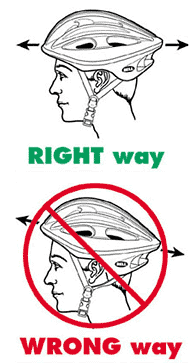Helmet Sizing and Fit
You wear a helmet to protect your head from injury, but you won't get the maximum protection unless it is properly sized with a snug, aligned fit. The information below is designed to guide you in achieving a safe, secure helmet fit.


Fit Tips
Look at the bike helmet example to the right. A helmet fits properly when:
- It sits squarely on the head with the front of the helmet low on the brow to protect the forehead
- The padding exerts firm, uniform pressure all around the head so that the skin on the forehead moves as the helmet is rotated from left to right and from front to back
If the harness isn't correctly adjusted, it's possible for the helmet to be knocked off or out of place. The harness is correctly adjusted when:
- The helmet sits squarely on the head with the front low on the brow to protect the forehead
- The front and rear straps form a "Y" just below and forward of the ears
- There is no slack when the chin-strap is fastened
General Tips:
- Do not wear a helmet tipped back on the head. Even if you can form the "Y" around the ears and eliminate slack, helmets worn on the back of the head are more likely to pop off and do not protect the forehead
- Buckle the chin strap securely at the throat. Connect the buckle according to the instructions provided with your helmet, and pull on the strap until it is snug against your throat. This ensures that your helmet will not come off at high-impact
